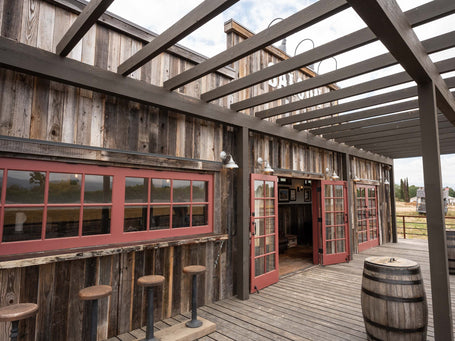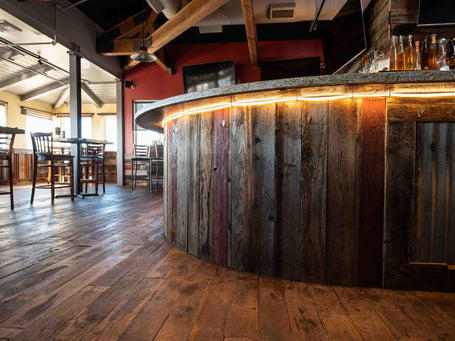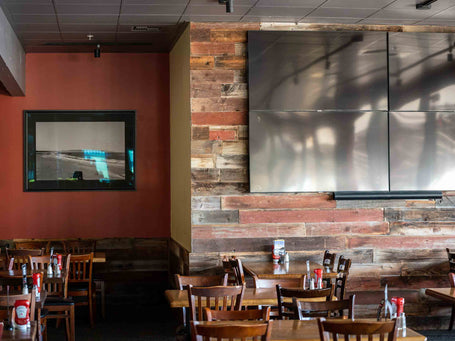Starting with Reclaimed Wood
When you choose to live in a tiny home, you embrace a lifestyle that values simplicity and reduced impact on the environment. The beauty of a tiny house is in its smart use of space, making it feel warm and welcoming. By using reclaimed wood, you can significantly boost the appeal and eco-friendliness of your tiny dwelling. Reclaimed wood brings a unique character and warmth that new materials often lack, turning your tiny house into not just a living space but a cozy retreat. This choice is fantastic for those who wish to infuse their home with personality and sustainability, telling a story with every beam and panel.
Advantages of Using Reclaimed Lumber in Tiny Homes
Eco-Friendly and Less Environmental Harm
Opting for wood from deconstructed buildings like old barns and factories helps lower the need to cut down new trees. This choice supports a way of living that takes less from nature and aids in recycling resources. By giving new life to existing wood, you help conserve forests, reduce waste, and support a sustainable lifestyle. This choice minimizes your home's environmental effect, as the energy needed to produce, process, and move new wood is already spent with reused timber.
Distinctive Style and Charm
Reclaimed wood offers a special charm, giving your tiny home a warm and inviting look. The aged textures and historical marks found in reclaimed wood make it unique, creating cozy and distinctive interiors for your living space. Each piece tells its own story with its unique grain patterns and color tones. These characteristics add personality and uniqueness, setting your home apart from others that may lack such detail.
Robustness and Practical Use
Old wood, having endured years of exposure, becomes more solid and stable compared to newer options. This makes it less likely to warp, crack, or shrink, which is ideal when every inch matters. Its strength and reliability match the demands of tiny house living, where every material must serve its purpose well. Reclaimed wood can be adapted for different uses—whether for floors, walls, or furniture. Its adaptability means you can have practical and stylish solutions that fit perfectly within your space.
Clever Uses of Recycled Wood in Tiny Homes
Wall Coverings and Flooring
Using old wood for your walls can give your tiny house a cozy and rustic look. You can make special accent walls or cover the whole inside with it. Each piece of wood has its unique colors and textures, providing a unique look that is also pleasing to the eye. For the floors in your tiny home, reclaimed wood is a strong and easy-to-care-for choice. Because reclaimed wood is sturdy and reliable, it works well for areas that get a lot of foot traffic.
Custom Interiors and Built-In Furnishings
Crafting bed frames with built-in storage from reclaimed wood can save space and add a touch of rustic simplicity. These pieces are not just beautiful; they are also practical, maximizing the limited space in your tiny living area. The solid nature of old wood ensures that your furniture can handle the everyday stresses of tiny house life. Consider making tables and countertops from reclaimed wood. A table can serve as a workspace, and a compact kitchen counter from reclaimed wood brings charm and character to your home.
Stylish Details
Adding recycled wood shelves and cabinets to your tiny home can provide extra storage and make it look great. These features are not only functional but also add to the visual appeal of your space. You can also use old wood to create unique art pieces or accents like headboards to express your personal style. These creative touches can make your dwelling a true reflection of your tastes, setting your tiny home apart with individuality and charm.
Practical Tips
Finding and Getting Ready Reclaimed Timber
When you are looking for old wood to reuse, find trusted places that give you good quality materials. Make sure the pieces you get are in good condition and still have their original charm. Inspect carefully to ensure durability. Once you have the wood, clean it well and get rid of any nails, screws, or metal bits. Sanding the wood helps smooth out rough areas or sharp splinters. It might be a good idea to apply a finish or sealant to make the wood look nice and protect it from water and damage.
Guidance for Installation
Plan and Measure: It’s key to plan carefully and measure exactly, especially in the tight spaces of a tiny home. Make sure you consider every corner and potential barrier before you start cutting and setting up the wood.
Proper Fastening: Make sure every reclaimed wood part is attached firmly to handle movement. Use strong glue, nails, or screws to keep everything stable. This ensures safety and durability, essential for long-lasting structures.
Why Choose Huasna?
At Huasna, you'll find top-notch reclaimed wood that boosts the look and environmental impact of your tiny house. Our barn wood is collected from genuine buildings, giving each piece a distinct story and charm. We focus on both eco-friendliness and durability, ensuring our materials are not only sustainable but also robust.
Whether you're living in a tiny house, taking on a DIY project, or designing professionally, Huasna supports your creative projects. Dive into our vast array of reclaimed wood and see how it can turn your space into a warm and eco-friendly retreat.
Frequently Asked Questions
What Should You Consider When Using Reclaimed Wood for Tiny Houses?
When using reclaimed wood in tiny house construction, you need to think about its strength and structural reliability. Check for damage like cracks, warping, or signs of pests. Look for pieces that retain their integrity and can bear the required load.
How Can You Ensure Safety and Longevity with Reclaimed Wood?
To ensure your tiny home is safe and durable, inspect reclaimed wood carefully. Remove any nails or fasteners and sand it to a smooth finish. Consider applying a sealant or protective coating to prevent future damage.
What Are the Costs of Reclaimed Wood Versus New Materials?
Cost-wise, reclaimed wood can sometimes be cheaper, especially if you find local suppliers or materials for free. However, premium reclaimed wood may cost more due to its uniqueness and rarity.
How Do Building Codes Impact the Use of Reclaimed Wood in Tiny Homes?
Always check your local building codes before using reclaimed wood. Some areas have regulations that might restrict certain materials. Make sure your reclaimed wood meets these standards to avoid future legal issues.
How Should Reclaimed Wood Be Prepared for Use in a Tiny House?
Before using reclaimed wood, clean it thoroughly to remove dirt and debris. Treat it to eliminate any pests and make it safe for indoor use. Sand the wood and apply finishes as needed for aesthetics and longevity.
What Are the Environmental Advantages of Using Reclaimed Lumber in Tiny Houses?
Using reclaimed wood helps conserve resources by reducing the need for new lumber. It gives old wood a new purpose and lowers the environmental impact of your build by minimizing waste.






